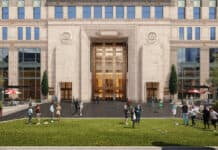 Instead of “Friday Funny,” this entry should be retitled “Fantastic Friday,” because it’s simply that: fantastic! In a style reminiscent of the 1927 film, “Metropolis,” combined with the comic book look of The Adventures of Tintin, the talents of another Belgian comic artist, François Schuiten take make believe urban landscapes to new heights.
Instead of “Friday Funny,” this entry should be retitled “Fantastic Friday,” because it’s simply that: fantastic! In a style reminiscent of the 1927 film, “Metropolis,” combined with the comic book look of The Adventures of Tintin, the talents of another Belgian comic artist, François Schuiten take make believe urban landscapes to new heights.
Born into a family of Belgian architects, Schuiten’s fantasy worlds stretch the boundaries of the imagination in ways that might make his more practical parents shake their heads in disapproval. “There is no budget-minded client, no structural engineer, no combative contractor, no urban planning quagmire, no pesky laws of physics to arrest the beautiful urban explosions that flow directly from Schuiten’s mind to the pen,” writes N. Rain Noe (aka “hipstomp”) on core77, an online design magazine and resource.
 In his article, Noe’s article concentrates on Schuiten’s 1980s graphic novel series, Cities of the Fantastic (original title, Les Cités Obscures), which serves as a visual commentary on the sterilization of the artist’s childhood hometown of Brussels. In his world, the grand and gorgeous historic buildings are preserved and even elevated to fantastic proportions. This serves as a direct contrast to the cold, stark reality of his city, where fabulous structures were destroyed in the mid-20th century and replaced with functional—but artistically uninspiring—modernist office blocks. It’s Schuiten’s term, Bruxellisation, that’s often used to describe the sterile reality that accurately describes Brussels (and many other European cities) today.
In his article, Noe’s article concentrates on Schuiten’s 1980s graphic novel series, Cities of the Fantastic (original title, Les Cités Obscures), which serves as a visual commentary on the sterilization of the artist’s childhood hometown of Brussels. In his world, the grand and gorgeous historic buildings are preserved and even elevated to fantastic proportions. This serves as a direct contrast to the cold, stark reality of his city, where fabulous structures were destroyed in the mid-20th century and replaced with functional—but artistically uninspiring—modernist office blocks. It’s Schuiten’s term, Bruxellisation, that’s often used to describe the sterile reality that accurately describes Brussels (and many other European cities) today.
From the Wikipedia entry on Cities of the Fantastic:
Coming from a family of architects, Schuiten had many relatives, especially his father and brothers, who were instrumental in Bruxellisation…and Schuiten was brought up to study architecture by his father, both in university and early on at home, while young Schuiten preferred to pursue his escape….Schuiten began drafting a parallel world of vintage architectural splendor reflecting his childhood memories of Brussels, a world which can be reached primarily through remaining buildings of these times gone by. In an ongoing attempt to prevent the spread of knowledge of this parallel world, mostly faceless authorities in our world increasingly have these buildings torn down, and in Schuiten’s world this was the true reason for chaotic, headless Bruxellisation [as perhaps another form of rebellion against the architectural work of his family?] where functional and organic buildings were destroyed in favor of ill-planned, useless, and confusing structures such as ill-planned roads, detours, freeways, and anonymous office buildings that destroyed the organic fabric of a city and resulted in dysfunctional traffic and living routines.
So given the choice between reality and fantasy, Schuiten created his own world. Fans of graphic novels and the steampunk style may already be familiar with his work, but for those of you who could use a little visual escapism this Friday, dig in and enjoy! Noe’s article includes several great illustrations and a few interesting additional links, sources, and interviews.


















![[VIDEO] Collect Asset Data at the Speed of Walking a Building](https://facilityexecutive.com/wp-content/uploads/2024/02/maxresdefault-324x160.jpg)